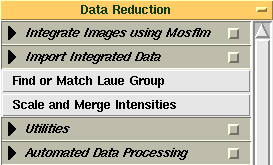Data processing with CCP4
From Media Wiki
Main Page - Using the CCP4 software - Data processing with CCP4
Data processing involves the analysis of the diffraction images to obtain a list of X-ray diffraction intensities, indexed by [h,k,l]. An attempt is then made to determine the spacegroup allowing symmetry related observations to be combined. Finally, structure factor magnitudes are calculated.
CCP4 offers both automated and non-automated data processing tools.
Contents |
[edit] Using data processing tools in CCP4
Data processing tools in CCP4 are all located in the Data Reduction module of CCP4i, accessed through the modules menu in the top left hand corner of the main CCP4i window.
[edit] Automated data processing tools in CCP4
CCP4 provides the following tools for automated data processing:
- Automated data processing with XIA2:
XIA2 is an automated data reduction system designed to work from raw diffraction data and a little metadata, and produce usefully reduced data in a form suitable for immediately starting phasing and structure solution.
[edit] Non-automated data processing tools in CCP4
CCP4 provides the following tools for non-automated data processing:
[edit] Data Integration
- Data integration with Mosflm:
Mosflm is a program for integrating single crystal diffraction data from area detectors. It is assumed that the experiment was conducted using the Arndt-Wonacott rotation/oscillation method, and also that monochromatic radiation was used. Mosflm can process data from a wide variety of modern area detectors, e.g. from Mar Research, Rigaku/MSC, ADSC, DIP etc.
[edit] Determination of Laue group & preparation of data for scaling
- Using Pointless for symmetry determination & preparation of data for scaling
The task Find or Match Laue group uses the program Pointless to determine Laue group symmetry, and possibly the space group, and write an output file in the most probable Laue group or space group, suitable for input to Scala. In cases where alternative indexing schemes are possible, it will find the indexing scheme which is consistent with a previously processed reference file. Multiple files from eg Mosflm can be combined. Files from XDS and Scalepack can also be read by Pointless: other formats can be read by the program Combat (from the task Import Integrated Data -> Import Unmerged Data (Combat)).
[edit] Scaling & merging
- Scaling experimental intensities with Scala:
The task Scale & Marge Intensities uses the program Scala to scale symmetry-related observations together, merge the multiple observations, and provide many statistics on data quality. Scaling is normally followed by conversion of intensities I to amplitudes |F|, using the program Truncate: this is part of the same ccp4i task.
[edit] Estimate structure factors from intensities
- Estimate structure factors from intensities with Truncate:
The task Convert intensities to SFs will estimate structure factor amplitudes from intensities. It also produces extensive analysis of the intensity statistics which may help to judge data quality and problems such as twinning. It is normally run automatically as part of the Scala task, but may be run separately to assess data from other sources.
